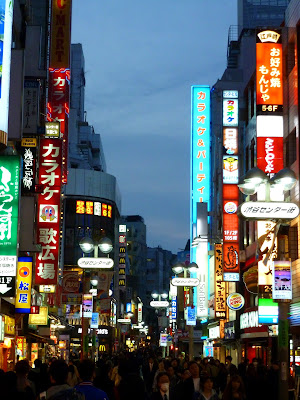"Uhm, is that good?"
"Yes! It's very beautiful!" the other office workers cooed in agreement.
"You have 7 heads" she then said frankly.
Now I was starting to get worried. Sensing my confusion, she reassured me: "Just like a model!"
I've never seen a model in Japan, but surely they don't have multiple heads...
"I only have 4!" Yumi-san said, laughing as she gestured to the ratio of the size of her head to her body.
Thankfully, my first day at the hospital wasn't filled with any other mind-boggling conversations like this.
Yoshimura-san asked me to check an introduction she had written for me (sort of like a poster detailing who I was, facts about London and what I'm going to be doing in the hospital. My picture was also printed on it). We then went to all of the offices, where she would introduce me, hand over a copy of my introduction and I then had to introduce myself. At one point, one of the office/department heads decided to try and use his English on me. He asked "How is your body?" (O_o) I assumed he was trying to say 'How are you?'
That afternoon, I helped take down the Hina-matsuri display. Hina-matsuri (Girl's Day) is a festival that takes place on 3rd March and it is celebrated by making a display of an Emperor, Empress and court attendants from the Heian period (9th-13th centuries).
| I didn't get to take any pictures, but this is one I found on the internet. |
On Tuesday, I went to the nearby YWCA (Young Woman's Christian Association) building to meet Hirata-sensei, who is going to give me five hours of Japanese lessons every week day until early April, when I begin volunteering in the hospital.
The lessons are really just long conversations. Apparently she's fluent in English, but she pretends to not understand things I say in English (when it's too hard to say it in Japanese), so I have to keep trying in Japanese. It's really hard sometimes! Although, my Japanese has improved a lot because of it.
She's a very kind woman, and she always brings out a tray of green tea and rice crackers at three o'clock. The caffeine is a real life saver...
On Thursday, Ueuchi-san took me out to eat Oden. It's a type of boiled food that is eaten in winter; it looks grey and unappetising, but it was delicious. He was adamant that I try everything, so I was stuffed by the time we came out.
 |
| There's a big metal container with all the food boiling away; ranging from cocktail sausages to quail egg and tofu. |
On the nights when I wasn't being taken out to restaurants, I had to somehow feed myself using a microwave and a toaster. It was not going well. Most nights I would just buy a bento from my local supermarket and then heat it up in the microwave, but one night I decided to be adventurous. I decided to boil an egg...
I went to the internet for help. That cornucopia of knowledge. One of mankind's finest achievements.
When the egg exploded in the microwave with a deafening bang, smashing a glass and covering the insides with warm, gooey egg, I realised that I should never have trusted WikiHow.
I was relieved when, on Friday, I was told I could use the kitchen on the fourth floor; I wouldn't have to risk my life experimenting with a microwave for 6 months!
There isn't an oven or gas hobs, just some weird electric plates that only heat up when there's a pan on them (and they heat up pretty much instantly, it's weird).
I have the whole kitchen and adjoining tatami room all to myself! Although this has proven quite bad for my mental health. There's an identicle kitchen on the other side of the room which can only be lit up with the switches on the far end (there's actually an identicle kitchen down there). Since I have dinner when it's already dark outside, it means the far half of the room is in darkness, and I sometimes hear things shifting down there (there's a lot of old boxes filled with things). This has led me to become paranoid that there's an evil, Japanese samurai ghost living down there, and it doesn't like me intruding on its lair. Therefore, when I'm eating, I always have to face that end of the room. Just so it can't sneak up on me and do any ghost-trickery...
I took this picture the only time I went down there to turn all the lights on.
There isn't an oven or gas hobs, just some weird electric plates that only heat up when there's a pan on them (and they heat up pretty much instantly, it's weird).
I took this picture the only time I went down there to turn all the lights on.
On the Friday night I made Oyakodon (chicken and egg rice bowl) using a recipe my Japanese friend in London helped me with.
I also made ramen the following night. Well, I used instant ramen and added some things on top...shhh...
I also made ramen the following night. Well, I used instant ramen and added some things on top...shhh...
My next post will be coming soon(ish). Read it to find out how to accidentally climb a mountain!

































































